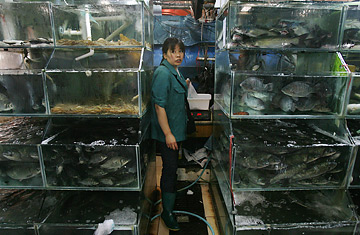
A vendor at a seafood market in Beijing. The U.S. Food and Drug Administration (FDA) said it would not allow imports of Chinese farm-raised seafood unless suppliers could prove the shipments contained no harmful residue.
Seafood and sushi eaters are navigating troubled waters these days. Ever since the U.S. Food and Drug Administration banned imports of certain farmed fish and shellfish from China last month, seafood fans have been nervous — especially the huge cohort of raw fish eaters converted to sushi and sashimi over the last two decades. And several industry veterans and watchdog groups say those worries appear to be justified. "It's really hit-or-miss," says Jeff Nitta, director of operations at Hokusai, a Beverly Hills sushi restaurant that zealously monitors the origin and quality of fish it serves. "People do need to be worried, depending on where they get their fish. There are a lot of chefs and fish market owners who are passionate about doing the right thing. But differentiating between those that are and those that aren't is the tough part."
The sushi lover can take some solace from the fact that the FDA's import alert said that the low levels of carcinogens it discovered posed no imminent threat to public health. But the FDA also admits that it doesn't know how much of the type of Chinese fish it has now banned has already reached the market . The agency only inspects about 2% of all seafood at the border. Just as unsettling, the U.S. doesn't require fish to carry country of origin labeling — which in any case is unreliable, industry experts say, because it is easy to fabricate. And while China — which accounts for some 70% of global farmed fish production — was the target of the alert, other Asian nations have also been cited in the recent past.
With so much fish from the region in circulation, with import regulations so easy to skirt, and with the federal government's inspection system so permeable, consumers must be especially vigilant when shopping at the market and ordering at seafood restaurants now, notwithstanding the ban. "The fish distribution system is so opaque and complicated that even many fishmongers and sushi chefs have no idea where their fish comes from," says Trevor Corson, author of The Zen of Fish: The Story of Sushi from Samurai to Supermarket. "They just trust their guy who trusts his guy who trusts his guy. Sometimes it leads to good quality fish being served, but other times fish gets to the restaurant and no one has any idea where it was caught."
To assess the rest of the fish that's on the market, here's what the experts advise:
1. Educate yourself, and ask lots of questions
"The consumer should demand to know where the fish is from and be a pain in the butt about it," says Nitta. "With sushi and other seafood restaurants, you probably ought to be careful about eating at places that are doing all-you-can-eat deals or that have cheap prices but don't look very busy, They are probably serving cheap, low-quality fish." He suggests adopting the habits of the top restaurant owners when they shop for fish. Nitta says Hokusai's chef and general manager go to the market each morning and buy only fresh fish and only deal with wholesalers with whom they have long, trusted relationships.
2. Don't let your eyes be your only guide.
To the uninformed, reddish pink hue in tuna and a bright white tint in hamachi yellowtail are freshness and quality indicators. Not so. Experts warn that some foreign processors have been known to spray fish headed for the U.S. with carbon dioxide to enhance the color or preserve its shelf life. Reading articles, studying pictures of fresh cuts of fish and then sitting at the bar and sampling them under the tutelage of sushi chefs are the best ways to learn about quality. It turns out that education has its privileges. In many cases, well-informed diners get VIP treatment from sushi chefs. "If they sense that you want to learn or already know what you're talking about, they will respect you more and serve you better-quality fish because they know you'll appreciate it," says Nick Sakagami, president of Trident Marketing, one of the nation's biggest distributors of fresh tuna.
3. Be prepared to pay more to insure quality and safety.
Industry insiders note that most of the recent scares have involved imported farmed fish that are low-priced, high-volume, mass-market products — not the high-end, pricey fare served in fine restaurants and sold in premium fish markets. In other words, when it comes to fish these days, you get what you pay for. "The age of fish sticks is over," says Corson. "We're going to have to abandon the expectation that we should be able to have high-volume, cheap fish whenever we want it. We're going to have to be willing to pay a premium at the fish counter for certified, sustainable seafood programs and the healthy fish they produce. "
Larger-scale reform has to take place, however, in order to give consumers guidance and peace of mind. A number of private efforts are under way. For example, researchers at Japan's Kinki University have developed technology to farm-raise bluefin tuna in a healthy, sustainable environment. All fish sold from the University's farm comes with a certificate of origin, diet and harvesting method. Meanwhile, the Marine Stewardship Council, an independent global nonprofit organization based in London, sends teams to investigate fisheries to make sure their harvesting methods are sustainable and contaminant-free. The Council then certifies the companies and their products. But the days of plenteous and easygoing sushi-gorging likely are history.
